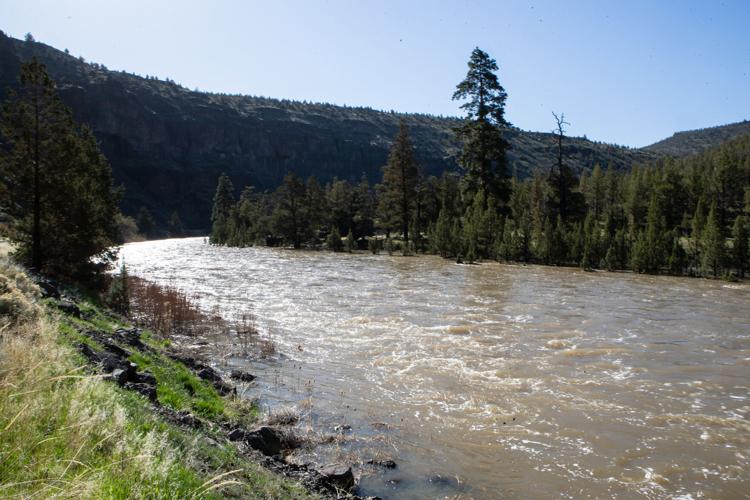This article was published on: 05/3/23 1:56 PM
By Michael Kohn
Water is flowing into the Prineville Reservoir at a rate not seen in several years, the latest indication that a devastating drought hanging over Central Oregon is beginning to ease.
As of Tuesday, Prineville Reservoir was 82% full and fast approaching capacity — a big turnaround compared to a year ago at the same time when the reservoir was just 28% full. It’s even a big recovery from the start of April this year when the reservoir was only 20% full.
The surge of water comes after a better-than-average La Niña winter that hammered the Pacific Northwest with storms in March. Snowpack in the Upper Deschutes and Crooked basin is 182% of normal and precipitation for the water year was 94% of normal.
The Crooked River subbasin has historically been volatile in terms of its water flows, and a high water level in Prineville Reservoir has been a rare sight for area residents.
“These inflows are not abnormally high. We just have not seen such a high snowpack in the Crooked River drainage in a long time,” said Jeremy Giffen, Deschutes Basin watermaster. “With the inflows where they are and the amount of snow still in the higher elevations, the reservoir has a very good chance of filling.”
Four-year high inflow rate
The peak flow into the reservoir a week ago was 4,380 cubic feet per second and in early April the inflow reached 7,340 cfs. Numbers that high have not been seen since May of 2019, said Giffen.
Water from Prineville Reservoir pours out of Bowman Dam into the Crooked River, which experienced dangerously low flows late last year that imperiled fish.
For around six weeks last fall, the flow from the dam was lowered to 10 cfs from 180 cfs, exposing large areas of the Crooked River. The flows from Bowman Dam outside irrigation season typically do not drop below 50 cfs, but last year dam operators were forced to make dramatic cuts due to the drought conditions that left the reservoir nearly empty.
Bruce Scanlon, general manager of the Ochoco Irrigation District, said he is following directions from the Bureau of Reclamation on flood control operations to prevent an overfilling of the reservoir. Over the past week, the release of water from Bowman Dam rose from around 130 cfs to over 2,700 cfs to make room for more water flowing in.
More water for farmers
The reservoir levels have opened the door to higher water allotments for farmers — long-awaited relief in an area that has been suffering from severe or exceptional drought every month for the past three years.
“It’s a big change. A group of farmers has been getting together every other Saturday and praying for moisture since February, and we are seeing fruit from that,” said Wade Flegel, an Ochoco Irrigation District hay and carrot seed farmer.
Crook, Jefferson, and Deschutes counties have all declared a drought emergency this year. The declaration helps farmers receive low-cost loans and other financial support.
The performance of other reservoirs that supply water to farmers has been a mixed bag. Wickiup stands at 63% full, a 26% increase compared to a year ago at this time. Crescent Lake is around 10% full, similar to last year’s levels.
Ochoco Irrigation District farmers currently have an allocation of 1.5 acre-feet, an amount that is expected to increase to 2 acre-feet or 2.5 acre-feet as reservoir levels rise, said Flegel. An average water year is 3 acre-feet.
“We have been on defense for the past three years, but now it looks like we can go on offense in order to actually get back to rotating our crops the way we would like to,” said Flegel.
But many farmers in Crook County also rely on the Ochoco Reservoir for water supplies. That reservoir is around 40% full — better than a year ago but with room for improvement. A higher level in Ochoco Reservoir is needed for farmers to return to full allocation.
“I do not see a situation where Ochoco Reservoir fills this year, but it is increasing to levels I did not think possible four to six months ago,” said Giffen.
North Unit operational issues
Crooked River water levels are also critical for patrons of the North Unit Irrigation District, which has water rights on the river.
But the higher-than-expected levels are causing operational issues for the district. At the district’s water pumping location on the Crooked River, workers have already pulled off fish screens in anticipation of additional river flows.
The pumps cannot operate when the fish screens are removed, said Mike Britton, executive director for North Unit Irrigation District. But removal is required now because the screens have electrical parts that could be damaged if they become submerged in water. The screens can also be damaged by debris in the water, which occurs during high flows.
“We can’t take water now even if we wanted to,” said Britton.
Britton adds that if flows continue to rise, the district’s Crooked River pumps will need to be removed.
“If there was ever a case when too much water is a problem, this, unfortunately, is it,” he said.




